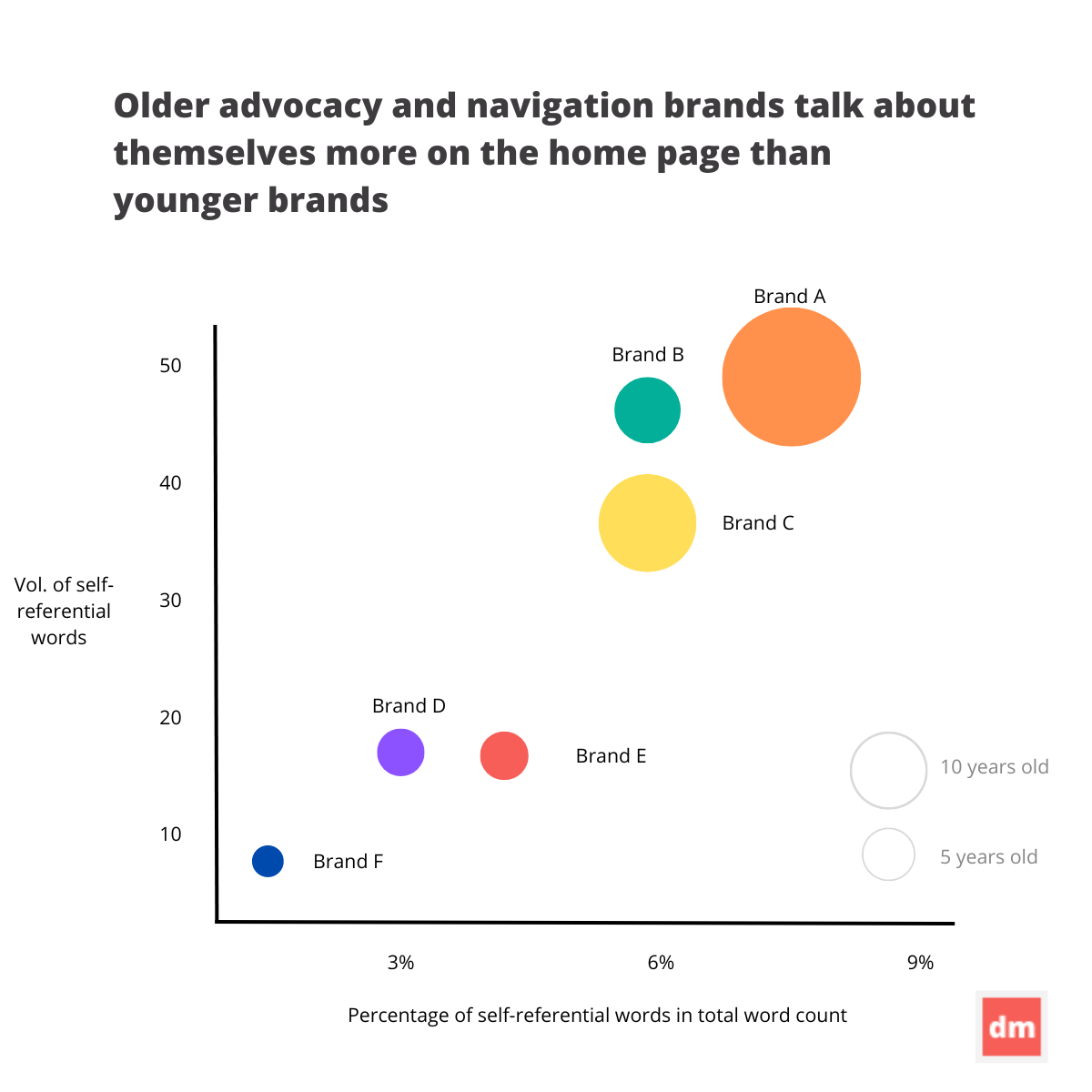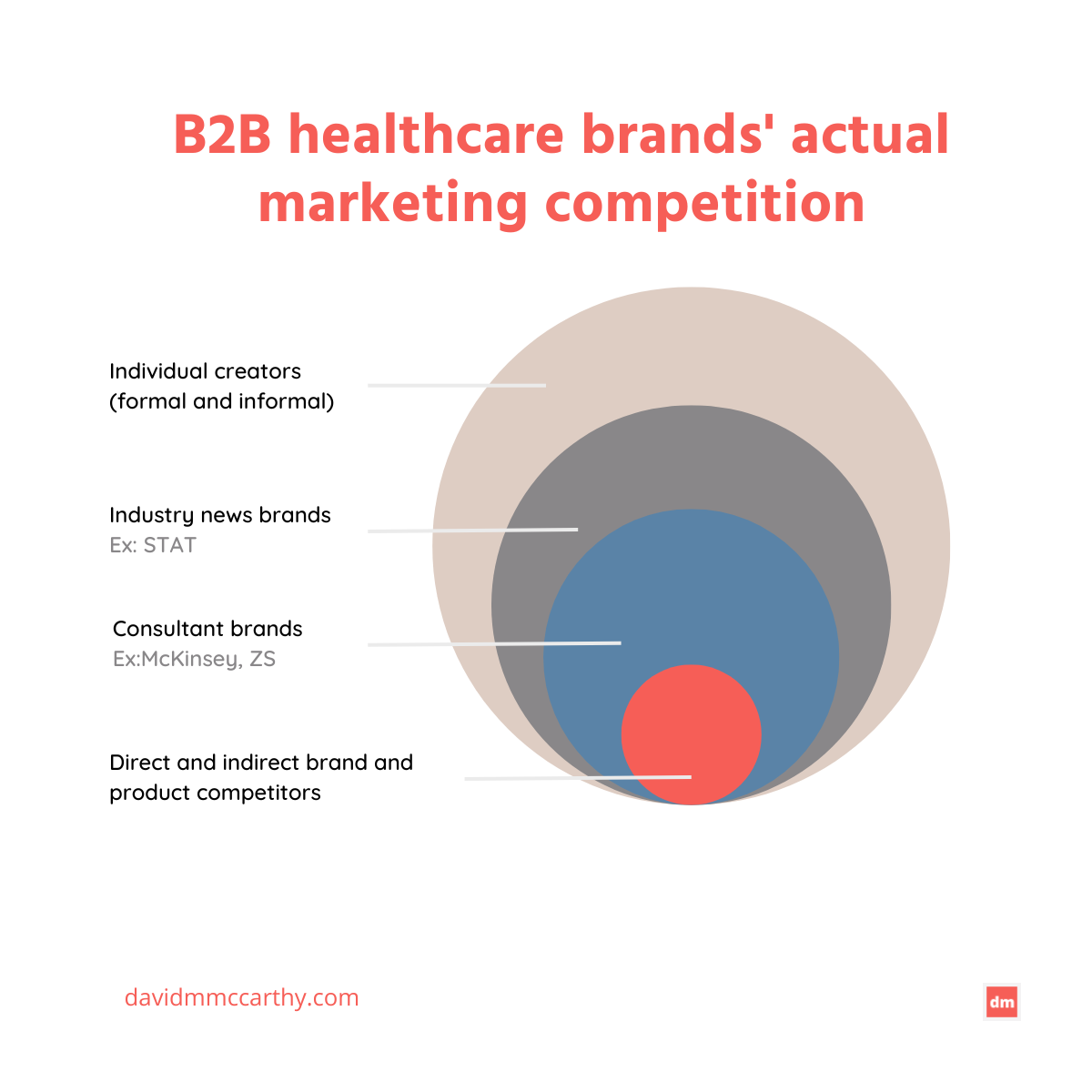The Differential | #8
David McCarthy
In this edition:
B2B healthcare marketing, in the feed: A16Z keeps its content engine running. Lyra and Evernorth wrap up their large conferences. And Pearl demonstrates how a brand can use awards to generate awareness.
Data point: Which advocacy and navigation brands talk about themselves the most on the home page—established brands or up-and-coming brands?
NEW - Promptly: Five prompts to spark social content for your clinical leaders.
Differential diagnosis: Generative AI will transform many marketers’ workflows and responsibilities. But is there another impact, especially in B2B healthcare, that’s going unnoticed?
Napkin draft: B2B healthcare marketers’ competition goes beyond just their respective brand and product competitors. So who else should teams monitor?
Four things on marketing tactics: The SERP will change dramatically based on Google’s I/O announcement; LinkedIn and Canva double down on employees as being key channels to drive business; and marketers are “meh” about Meta’s new app.
1:1 Office hours: A free 45-minute session to brainstorm and untangle marketing and content projects.
B2B healthcare marketing, in the feed
Andreesen Horowtiz’s engine isn’t slowing. The firm published a landing page the outlines their thesis for merging healthcare and fintech capabilities, and they shared their fifth and final playbook on digital health GTM — selling through channel partnerships. → Read more
Oy! At Lyra Health’s conference, Breakthrough, Brett Goldstein, who plays Roy Kent on Ted Lasso, spoke, in addition to leaders from Zoom and Starbucks. → Read more
Cigna’s health-services brand Evernorth wrapped up their conference, Outcomes, recently. The event focused on “elevating benefit offerings, improving total population health, and unveiling what’s possible through the power of Evernorth.” → Read more
In what seems like a (sub)category-design play, CertifyOS shared an article differentiating provider network management and provider intelligence. → Read more
Abacus Insights’ senior director of solution strategy penned a LinkedIn article on how they differ from other health-data companies. I genuinely appreciate the “on-the-nose-ness” of this. Many brands veil their differentiation messaging too much, in my opinion, forcing prospective buyers to discern differentiators for themselves. → Read more
Pearl Health released their second annual Top 50 Value-Based Care Thinkers list. From an awareness perspective, I appreciate these types of plays. They can attract inbound links and seem to generate a lot of social engagement across different relevant connection networks. (One organic post about the list generated 120-plus engagements and 20 reposts alone.) → Read more
apree health shared its 2023 Workforce Health Index. Much like “state of” reports, indices like these work best, in my opinion, when the angle is unique or hyperspecific and when the data is differentiated. From a content-marketing perspective, these are a gold mine of content breakouts. → Read more
And now, some data on content
Within the healthcare advocacy and navigation category, messaging about customer and consumer centricity is quite prevalent.
But many brands in the space seem to approach that messaging differently, especially on their website's home page, where, often, a brand conveys their value proposition and introduces what's possible.
For example, based on rough observation of some well-known brands in the advocacy and navigation market, older brands tend to talk more about themselves on the home page. They use their brand name more frequently, and they use first-person pronouns more frequently.
Younger brands, meanwhile, take the opposite approach, it appears. They use self-referential language less frequently, focusing more on the customer and their jobs, via second-person language, like "you" and "your."
Promptly
Five Quick prompts for clinical leaders’ LinkedIn content
Like most of B2B marketing, healthcare and digital health marketing is likely evolving from its top-down NFL era into its flatter NBA era: like NBA players, employees have become prominent ambassadors that help build brand equity and, perhaps most importantly, establish trust and new channels with prospects.
Within our healthcare and digital health world, clinical leaders can carry the same appeal that top-tier athletes do. Yet many clinicians struggle to establish a regular habit of sharing their points of view with prospects or even the public at large.
The five prompts below intend to help marketing and operator leaders spark micro-thought-leadership ideas for their respective brand’s clinical leaders.
Social platforms are filled with posts about the failure and inefficiency of the healthcare system. Take a positive-contrarian position: what initiative, policy, technology breakthrough, or modality is working but not getting the attention it deserves?
Healthcare is in a new era of technological innovation. Identify and describe the innovation that excites you most, and compare its possible impact to that of an invention in the past. (The catch: you can't compare it to the iPhone, T-model, or printing press.)
Name the likely winner of the next era of healthcare. What are they doing differently, and what impact has that difference made across the healthcare system?
Few industries involve as many stakeholders as healthcare does. Which stakeholder deserves a louder voice? Why, and what's the potential impact of that?
Imagine you have the power to test a new payment model that rewards innovative, efficient, high-quality care for a particular population. Which population or condition would you target, why, and what does the model look like?
A differential diagnosis
The other side of Generative AI’s impact
TL;DR: The flood of content that generative AI tools will produce may make it even harder for buyers to sift through noise for signals they can trust.
Early takes from marketers on ChatGPT and other generative AI tools — that marketers' productivity can soar and that SEO may be at risk, for example — have been enlightening. However, many of these predictions have focused on the supply side of the B2B buying equation, or the work that marketers themselves are responsible for.
There’s another side of the story that, from my perspective, hasn’t been focused on much. Generative AI tools will almost certainly impact the other side of the equation—the demand side, or the buyer, and add another layer of complexity their already-complex journey.
Within B2B healthcare marketing, effective content signals differentiating expertise and cultivates a sense of trust within the buying team. The blog series that distills a new intricate, technical reimbursement policy into simple takeaways, for example, can be an early origin of a long-standing partnership between an up-and-coming health-tech company and an established enterprise buyer.
But if AI technology can not only level the playing field when it comes to educational content but multiply it, how do B2B healthcare brands still signify their credibility? And how can buying teams discern which brand is a partner they can rely on?
Some content plays and tactics that may be able to help counter these dilutive effects of generative AI are for brands to:
Leverage employees' own brands and channels
Design a hyperspecific, hyperunique narrative that can win in any feed
Double down on technically rich “boring content”
Reimagine what “content” means or can be (e.g., think of content as a product)
Weave in more of your brand’s operating frameworks and proprietary research
Lean on customer stories
Make sense of the buying journey for the buyers
Content will still be an essential lever worth investing in because of its ability to scale. But I suspect that the B2B healthcare brands that plan around the new AI reality now will see more efficient production, acquisition, and retention down the road.
Napkin draft
Who are your actual marketing competitors?
In B2B healthcare marketing, if a brand is aiming to be a community-building thought leader and market educator, it's useful (and sobering) to remember that their marketing competition is broader than their brand or product competitors.
For example, many leads of an enterprise buying team are probably regular readers of:
- CMS and CMMI
- STAT News
- Fierce Healthcare
- Becker's
- Modern Healthcare
- Deloitte
- McKinsey
- ZS
- Willis Towers Watson
- Health Affairs
- NEJM Catalyst
- Individual creators and influencers
With that many voices in the space, a distinct point of view and distribution-focused content strategy are no longer optional in B2B healthcare.
Four things On marketing tactics
It sounds like a broken record, but the search results page experience we’ve known will likely be gone for good, based on what Google announced at their conference. → Read more
Early this summer, LinkedIn is reportedly going to launch a feature that enables brands to promote content through their employees’ profiles.
Marketers may not rush to adopt Meta’s supposed Twitter killer. → Read more
Canva’s latest product launch suggests that they are betting big on employees becoming creators for their employer’s brand. → Read more
Virtual office hours
Free | 1 to 2 team members | 45 minutes
In B2B healthcare, content engines can get stuck fairly quickly. Ideas to engage sophisticated, scrutinizing buying teams are hard to come by, stakeholder reviews can stall projects, and limited resources can threaten output and distribution.
Sometimes, an outside point of view can help uncover new possibilities and solutions.
I’m piloting one free 45-minute brainstorm in June to help 1 to 2 members of a B2B healthcare marketing team “unstuck” their content engine.
We can work together to tailor the agenda, but some potential challenges to cover include:
Topic generation
Content planning, including tools
Content reviews
Content prioritization
Content atomization, or repurposing
Given how casual the conversation aims to be, it’s best for 1 to 2 team members rather than an entire team.
I post on LinkedIn, too
A brief disclaimer
I reference and link to many healthcare brands in the newsletter. Including them does not signify an endorsement of their business.


